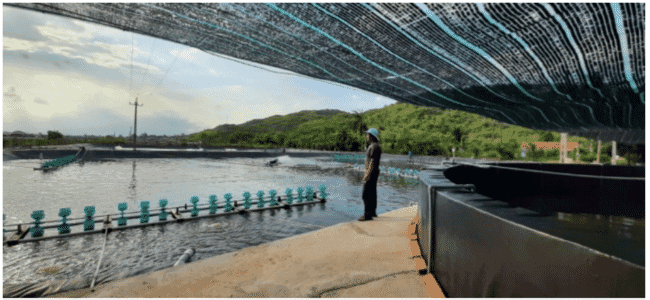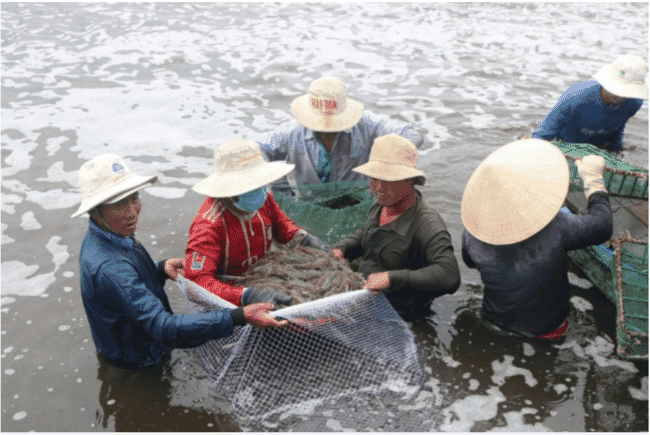
© TL
The agriculture extension centre built experimental shrimp farming ponds between 2020 and 2021 as part of its science and technology research programme. During their trials with whiteleg shrimp, researchers with Binh Dinh started an intensive aquaculture experiment using semi-biofloc technology. According to Tran Quang Nhut, deputy director of the extension centre, the model has produced positive results.
Quang Nhut explained that semi-biofloc uses microalgae to clear and stabilise the water environment. A “biofloc” includes heterotrophic bacteria, algae and humus that helps control water quality and provides a rich food source for the farmed shrimp. The bacterial and algal flocs also prevent pathogens from proliferating in the culture water. If deployed correctly, bioflocs can drastically reduce shrimp diseases and minimise mortalities.
In 2021, the extension centre and local community began creating a semi-biofloc system and began farming shrimp with the method. Initial results showed that the effort gave an economic benefit to the community, increased farmer incomes and improved the local water ecosystem.

© Kim So
Nhut and the farmers found that semi-biofloc doubled shrimp outputs when compared to conventional farming methods – mainly because the method permitted higher stocking densities. The trial also showed that input costs could be reduced by 10 to 15 percent because farmers did not have to spend money on antibiotics or other medical treatments. Farmers also reported lower levels of food loss. At the end of the trial, the team found that groundwater consumption was minimised when compared to traditional shrimp farming. Nhut noted that the microalgae regulated the water environment.
When speaking about the trial, Nhut said, “semi-biofloc technology is easily accessible to farmers. Farmers, in particular, must grasp the process of pond treatment; they must closely monitor the water level and master the molasses incubation technique and floc mass culture.
“In comparison to traditional agricultural operations in Binh Dinh, the implementation of semi-biofloc technology provides several economic benefits. Due to the fact that shrimp farming production may reach 20 to 40 tonnes per hectare for each crop when using semi-biofloc technology, each kilogram of farmed shrimp can lower expenses by 10-15 percent when compared to prior methods,"

© Kim So
In 2022, the Binh Dinh Agriculture Extension Centre’s semi-biofloc unit will partner with the districts of Phu Cat, Phu My and Hoai Nhon communes to establish three white-leg prawn farming models on a 1,500 m2 scale using the technology.
Nhut says that between 2021 and 2025, the shrimp sector will prioritise creating high-tech and biosecure sites that mitigate environmental pollution. Semi-biofloc will help the industry achieve these goals while targeting intensive production volumes.




